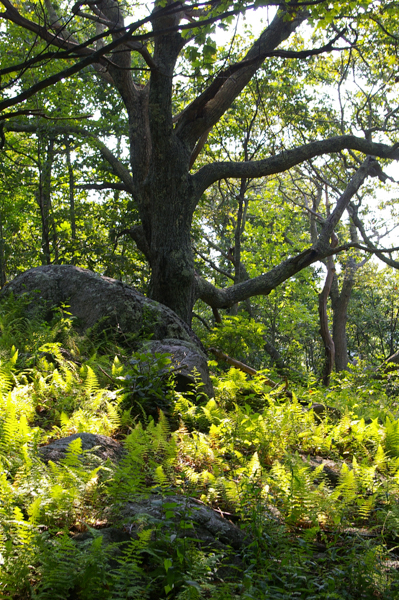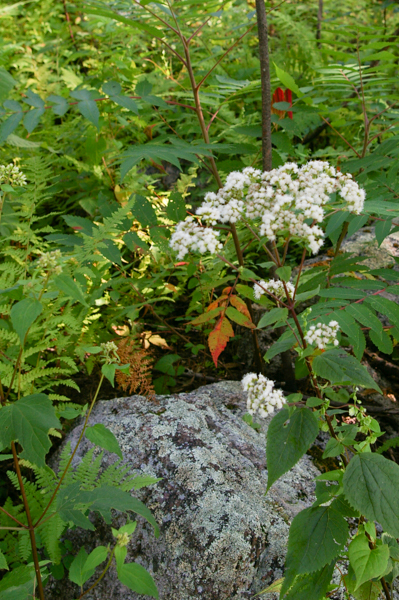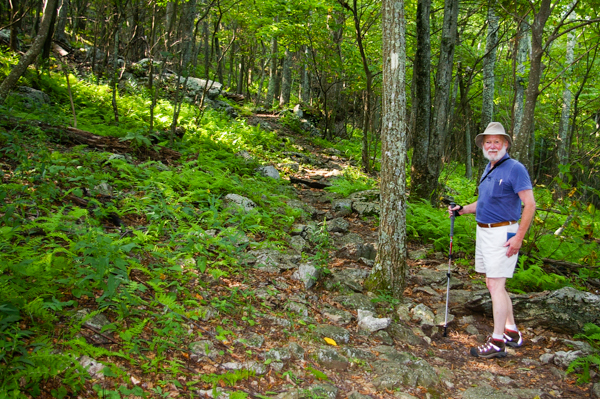Appalachian Trail
One Friday , 17 August, the Newcomers hiking group met for a four-mile out-and-back hike along Tar Jacket Ridge on the Appalachian Trail or AT as it is known to many. It was a beautiful mid-August morning with almost a nip in the air after a long scorching summer. We walked amid late-summer flowers and butterflies. Since I had my camera, Jim and I turned around before the others so that I could have time to take some pictures of the flowers.
 A
friend once complained that most of the AT was in the woods and there
were few places where you could find scenic views. Well, this is one
of the places. This is the view north from the ridge, but there was
a 180-degree vista from this ridge. It is clear why these mountains
are called the Blue Ridge.
A
friend once complained that most of the AT was in the woods and there
were few places where you could find scenic views. Well, this is one
of the places. This is the view north from the ridge, but there was
a 180-degree vista from this ridge. It is clear why these mountains
are called the Blue Ridge. Although
we saw plenty of bear scat, we didn't see any animals -- mostly
butterflies. I have only rudimentary identification skills, but
based on this and other pictures I took, I believe this is a
Pipevine Swallowtail. According to the field guides, however,
there are several similar species. The Pipevine, like the Monarch,
is unappetizing so others mimic it.
Although
we saw plenty of bear scat, we didn't see any animals -- mostly
butterflies. I have only rudimentary identification skills, but
based on this and other pictures I took, I believe this is a
Pipevine Swallowtail. According to the field guides, however,
there are several similar species. The Pipevine, like the Monarch,
is unappetizing so others mimic it. Our
county is called Rockbridge after the Natural Bridge, but that is not
the only rock feature in the area. We have lots of rocks. I thought
this looked like a sofa that a giant might enjoy -- if he didn't
need cushions.
Our
county is called Rockbridge after the Natural Bridge, but that is not
the only rock feature in the area. We have lots of rocks. I thought
this looked like a sofa that a giant might enjoy -- if he didn't
need cushions. Another
rocky feature along the trail was this man-made structure. In former times folks
brought their pigs into
the woods to forage. This was one of the walls of the "pig
pen" used to corral them.
Another
rocky feature along the trail was this man-made structure. In former times folks
brought their pigs into
the woods to forage. This was one of the walls of the "pig
pen" used to corral them. Most
of our walk was in the woods. The trees were dense in some places, but
usually the woods were open and allowed a lot of sunlight through. The
light makes these ferns glow.
Most
of our walk was in the woods. The trees were dense in some places, but
usually the woods were open and allowed a lot of sunlight through. The
light makes these ferns glow. Among
the common native wildflowers were these
white wood asters, found here with ferns and sumac.
Among
the common native wildflowers were these
white wood asters, found here with ferns and sumac. I've
not been able to identify this beauty yet. It may be a kind of viburnum.
I've
not been able to identify this beauty yet. It may be a kind of viburnum. These
little bright orange mushrooms were plentiful throughout the wooded
areas. As they grew larger they began to look a lot like
chanterelles.
I've eaten wild-harvested chanterelles when I've been with experienced
mushroomers, but I wouldn't dream of trying to pick my own. Moreover,
based on other pictures that I took, these could well be false chanterelles,
which may not be poisonous, but aren't particularly tasty either.
These
little bright orange mushrooms were plentiful throughout the wooded
areas. As they grew larger they began to look a lot like
chanterelles.
I've eaten wild-harvested chanterelles when I've been with experienced
mushroomers, but I wouldn't dream of trying to pick my own. Moreover,
based on other pictures that I took, these could well be false chanterelles,
which may not be poisonous, but aren't particularly tasty either. This
is one of the more heavily forested areas. Unlike the Chessie Trail,
the AT can be pretty rugged. It would be easy for a careless hiker to
trip and fall. I did topple over early on before I got used to balancing
my day pack, but luckily it was on soft grass rather than rock.
This
is one of the more heavily forested areas. Unlike the Chessie Trail,
the AT can be pretty rugged. It would be easy for a careless hiker to
trip and fall. I did topple over early on before I got used to balancing
my day pack, but luckily it was on soft grass rather than rock. We
were surprised to see
columbines still blooming. They make a striking contrast against
their leaves, which have started turning to their fall colors.
We
were surprised to see
columbines still blooming. They make a striking contrast against
their leaves, which have started turning to their fall colors. When
I took this photo I thought it was common stickweed with great back-lighting.
Since trying to find out more about stickweed, however, I've come
to the conclusion that it is more likely to have been a
cutleaf coneflower based on the lobed leaves that can be seen in
the background.
When
I took this photo I thought it was common stickweed with great back-lighting.
Since trying to find out more about stickweed, however, I've come
to the conclusion that it is more likely to have been a
cutleaf coneflower based on the lobed leaves that can be seen in
the background. I
loved the contrasting leaf colors and shapes of this foliage.
I
loved the contrasting leaf colors and shapes of this foliage. Here
are two different native clematis. The purple bell-shaped flower belongs
to
Clematis viorna and the white flowers with the large leaves are
Clematis virginiana. The white clematis was found all over, the
purple ones not so much.
Here
are two different native clematis. The purple bell-shaped flower belongs
to
Clematis viorna and the white flowers with the large leaves are
Clematis virginiana. The white clematis was found all over, the
purple ones not so much. What
would a late summer hiking log be without a picture of goldenrod? I
read somewhere once that identifying a particular species of goldenrod
is an exercise for a specialist. Personally I love them all.
What
would a late summer hiking log be without a picture of goldenrod? I
read somewhere once that identifying a particular species of goldenrod
is an exercise for a specialist. Personally I love them all. Our intrepid crew headed down to the trailhead parking lot. Although
the lot was full to overflowing we didn't meet any other hikers
during our time out. They must have fanned out in other directions.
Our intrepid crew headed down to the trailhead parking lot. Although
the lot was full to overflowing we didn't meet any other hikers
during our time out. They must have fanned out in other directions. Our
final stop was the Buena Vista visitor's center where we had met
to carpool up the mountain. I saw a lot of my favorite
Joe-Pye weed on the trail, but none of it was as exuberant as this
stand, which has been lovingly tended by the
Rockbridge Area Master Gardeners.
Our
final stop was the Buena Vista visitor's center where we had met
to carpool up the mountain. I saw a lot of my favorite
Joe-Pye weed on the trail, but none of it was as exuberant as this
stand, which has been lovingly tended by the
Rockbridge Area Master Gardeners.I love this plant and tried with no success to get it established in our wildflower meadow at our farm in Northern Virginia. Maybe I'll try again at our home in Lexington – although it is a bit large for a suburban lot.